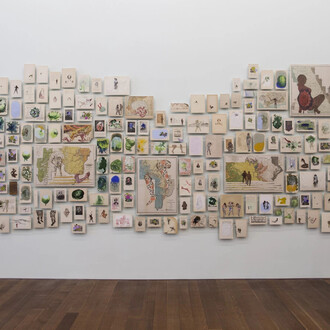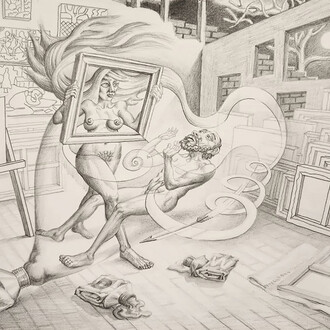The Art Institute of Chicago is pleased to present focus: Lucy McKenzie, the largest U.S. exhibition to date of the work of the Scottish-born artist. The exhibition will be on view in the Modern Wing’s Abbott Galleries October 23, 2014, through January 18, 2015.
McKenzie (born 1977) is known for her use of illusionistic effects, including trompe l’oeil (French for “deceives the eye”), in her paintings. She borrows carefully researched material from multiple sources, appropriating imagery, objects or motifs that reference cultural as well as personal compulsions. From these she typically produces still lifes and architectural sequences, often painted at one-to-one scale.
Trained in 19th-century techniques of decorative painting, McKenzie renders a vast range of materials—dog-eared paper, veined marble, aging plaster—in oil paint with meticulous fidelity. But these paintings are just one aspect of her work. She undertakes projects in a variety of media, from genre fiction to film decor to clothing and interior design, creating environments, scenes and contexts as much as individual artworks.
For this exhibition, organized by Kate Nesin, associate curator in the Art Institute’s Department of Contemporary Art, McKenzie reimagines the museum’s Abbott Galleries as a dynamic shop window, an airy expo hall and an intimate artist’s studio, all with an eye toward mining her past. Twelve new canvases and a recent video installation either make direct reference to her student-age works of the 1990s or include references to formative themes in her paintings from the early 2000s. While appropriation has been central to her practice for more than 15 years, here the artist appropriates elements from her own working vocabulary. In McKenzie’s words, “Thinking about how the access to and consumption of images has changed in recent years, I wanted to re-examine my relationship to appropriation. Every quote is an acquisitive, colonizing act, so how can one appropriate without inherent exploitation? By appropriating oneself?”
This show begins with a bank of windows in the Modern Wing’s Griffin Court that give the appearance of a shop display. Inside, a featureless mannequin perches on a slender-legged table. Next to the figure are a spiral-marked disk, spinning constantly clockwise, and an outsized arrow, bouncing up and down within the window’s frame. The mannequin strikes a still contrast to the ever-moving items: It sports a leotard and rubber-soled slippers—activewear on a frozen form.
The table on which the mannequin sits is a quodlibet, a type of trompe l’oeil painting that presents everyday items such as letters, playing cards, news clippings, books, etc., in apparently accidental array. The muted green surface in Quodlibet XXXX (2014) is spread with faux printed materials that reference a group of 20th-century artists and theorists, all of whom were either accused of or linked to pedophilia in their personal lives. Thus, as the first painting a visitor to the exhibition encounters, Quodlibet XXXX raises concerns about expectations and complicity: What do we want or need to know about our artists, and to what extent does biography aid or impede the analysis of the work they produce?
The first gallery features three mechanisms of display: temporary panels that stand free from the walls, a vertical wooden rack that calls to mind an artist’s studio storage cabinet, and a vitrine—built to match three additional table-paintings—that contains real printed matter rather than painted facsimiles. Quodlibets XXXVII, XXXVIII and XXXIX (2014), like the painting/tabletop in the window, depict books laid out on dupioni silk. Meanwhile, four new paintings installed on floor-to-ceiling panels present romantic landscape fragments—drooping branches against a rosy sky—that contain unexpected layers of filmic, as well as comic, meaning.
In the show’s second gallery, McKenzie inserts images of herself most directly. Untitled (1997), painted while she was an undergraduate, shows the artist dressed as a gymnast and posed after a dressmaking pattern. Three paintings hung on stanchioned panels, while created in 2014, reach back to the 1990s for inspiration. Quodlibet XXXII presents a tightly clustered selection of pages from the “Riot Grrrl” fanzine a teenage McKenzie published between 1991 and 1995. Quodlibet XXXIV reprises photographs of the artist and her friends styled after champion Soviet gymnasts in 1998–99. Quodlibet XXXIII re-renders, with breathtaking illusionism, a hand-painted poster McKenzie made in the late 1990s but never exhibited. A fourth, stand-alone painting, Untitled (2014), isolates the kind of faux marbling that backs these three large Quodlibets and achieves instead a quiet, almost meditative abstraction.
Finally, in the 2014 video The Girl Who Followed Marple, made in collaboration with Richard Kern, McKenzie appears in dowdy clothes and aging makeup, playing an alternately blasé and suspicious version of Agatha Christie’s fictional lady detective, Miss Marple. At the end of the video’s short loop, the Marple character reveals herself to be only 36 – a gleeful verbal disclosure that McKenzie affirms by lifting her blouse to display her actual body. If self-appropriation was the artist’s thematic prompt for this exhibition, the possibilities and impossibilities of revelation and access are its potent, tantalizing through-lines.



















